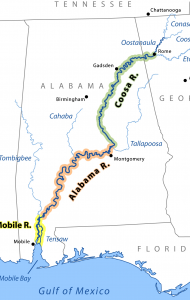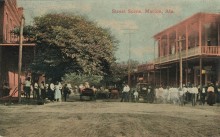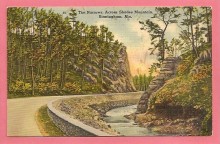This story and others can be found in the Alabama Footprints Series by Donna R. Causey
Nobodies became Somebodies in early Alabama
From 1798 through 1820, the population in the Mississippi Territory soared from less than 9,000 to more than 222,000. Migration came in two distinct waves. There was a strong movement until the outbreak of the War of 1812. The second wave began in 1815, and turned into a flood through 1819 when Alabama became a state. The postwar flood of settlers was created by various factors included high prices for cotton, the elimination of Native American titles to land, new and improved roads, as well as the acquisition of new direct outlets to the Gulf of Mexico.

First Migrants
The first migrants were traders and trappers, then herdsmen, and finally farmers. During this first wave, migration into the Natchez District and the Tennessee Bend was steady while the movement of settlers into the Tombigbee area was not as great. The War of 1812 and Creek-Indian War slowed the migration only briefly.
After the war of 1812, and with the defeat of the Creek Indians, there was a massive movement for land in Alabama which had been ceded to the United States in the Mississippi Territory.
Land became part of public domain
When the Native Americans ceded land, the United States government became the owner and the land became part of the public domain. The federal government issued land grants to purchasers in the Mississippi Territory. Thousands of immigrants took advantage of this opportunity.
“The land had to be surveyed before it could be sold, but the immigrants were impatient. They rushed in during this period of Alabama fever laid claim to tracts, and became squatters.”1
State immigrants congregated in various parts
Some of the first settlers of Alabama came from Virginia, Georgia, Tennessee, South Carolina, and North Carolina. Wagon trains from individual states formed and they tended to congregate and settle in various parts of Alabama.
 Map of Alabama
Map of Alabama
The Georgians settled in the eastern part of the State while further west and south were the North Carolinians and Virginians. Some North Carolinians and Virginians also settled in North Alabama, especially Huntsville. Tennesseans tended to settle in the northern part of the state and further south in the counties of Bibb and Shelby.
Settlers in what was to be Cahaba, later Bibb County, were first attracted to this “valley of very inviting land” when they were fighting the Indians with Andrew Jackson in 1814.1 In the regions around Montgomery, Georgians predominated for a long time while Virginians and Carolinians were in the counties of Perry, Greene, Tuskaloosa, Marengo, Dallas, Monroe and Wilcox.
In west Alabama around Florence, land buyers included President James Monroe, John Coffee and Andrew Jackson. New towns began to spring up everywhere as the population increased, such as Clayton, Russellville, Claiborne, Athens, Demopolis, Eaglesville, Cahawba, Selma, Northport and Montgomery. With the possibility of statehood imminent, settlers began moving into the central part of the Alabama Territory.
Another group of people later came for free bounty land. After the Revolutionary War, free bounty land was offered by the federal government to citizens and soldiers for their service. The practice of awarding bounty land for military forces had been a long-standing practice in the British Empire in North America since land was usually a commodity in generous supply. Before 1842, the bounty land was only awarded to veterans and heirs of veterans of the War of 1812. The bounty land was only awarded in designated districts and did not include Alabama. It was not until an act in 1842 that claimants received any federal land in Alabama.
Additionally, Acts in 1850 and 1855 offered bounty lands to veterans and heirs of veterans of all conflicts from 1790 forward. An act in 1855 granted bounty lands on service for as little as fourteen days. This changed again in 1856 when bounty lands were only offered based upon Revolutionary War service. There are over 700 known Revolutionary War soldiers who resided in Alabama.
Once immigrants settled in the Mississippi Territory it was not unusual for families to try out several locations before finally deciding on a final location. Often, new settlers acquired land, then sold it at a profit and moved on to another area. It is through these means that former subsistence farmers were able to acquire a comfortable living.
Purchasing federal land from the United States government was often complicated and expensive. Until 1796, purchasers had to pay for the land in cash, no credit was allowed. Finally, Congressional Acts in 1796 and 1800 allowed settlers to buy lands on credit. This encouraged many immigrants to simply travel to the new land, even before it was surveyed or offered for sale, and pick out a spot to settle as a squatter. Then, once the land was surveyed and offered for sale, they bought their land on credit.
1Ellison, Rhoda Coleman, Bibb County, The First Hundred Years, p.12
This story and more can be found in Alabama Footprints – Immigrants
ALABAMA FOOTPRINTS Immigrants includes some lost & forgotten stories of their experiences such as:
- The Birth of Twickenham
- Captain Slick – Fact or Fiction
- Vine & Olive Company
- The Death of Stooka
- President Monroe’s Surprise Visit To Huntsville





You would think that this story would mention the very 1st settlers & town. Mobile and the surrounding coastal lands were settled by the French long before these migrations. There was a Scots influx after ‘the clearances’ in the mid 18th century that lasted until the beginning of the turn of the next one. They settled mostly in South Alabama and created several small communities. After Napoleon wrested the Government from the Bourbons there was a second, and heavy, migration of French immigrants who settled mostly in west central Alabama.
Much of South Alabama was still under Spanish control in 1798. This article is mainly about the organization of the Mississippi Territory. But there are several other stories about early settlements on the site such as this one: http://alabamapioneers.com/mobile-alabama/#sthash.6x747eZ7.dpbs You can use the search box to find them. It is impossible to include them all in one story. That would take an entire book. Actually, it has taken six books so far in our Alabama Footprints series http://amzn.to/1OnyO57 and we’ve only scratched the surface.
The original land deeds one dated 1826 by John Q Adams for my Calvert family line is still in the family. There are 3 total, signed by 3 different Presidents.
Several of my ancestors received land grants through the federal office in Hunstville.
researching on William G. Gore, believed born in the territory in 1813.. My G/grandfather Jesse Gore as well as the one brother, Asa Gore, who we found buried in Dallas, Tx…. Speculate that Asa was named after Asa Gore who died in 1778 in the attack Wyoming Valley Pennsylvania… Rather sure that Ellen ( no name).. also was a Cherokee, and they came together sometime about 1830 in Mississippi, rather than the Alabama side..